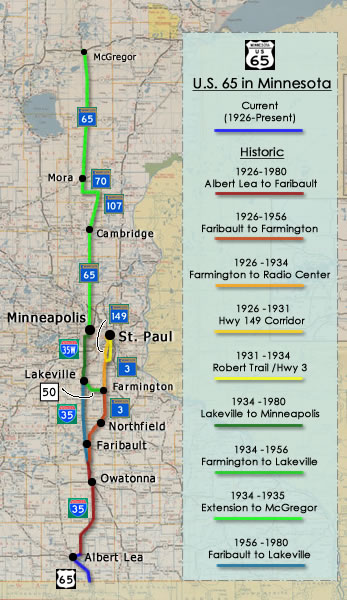

 Historic U.S. Highway 65, Minnesota
Historic U.S. Highway 65, Minnesota

U.S. Route 65 is probably best remembered as the predecessor of I-35/35W between Minneapolis and Albert Lea. However, it started out as a route to St. Paul, and in fact underwent more changes than any other U.S. route in Minnesota. Today, U.S. 65 is little more than a stub of its former self, running only 15 miles from the Iowa border to I-35 at Albert Lea.
1926-1934: Route to St. Paul
U.S. 65 was one of the original north/south routes of the U.S. Highway system, officially adopted in November, 1926 (Minnesota started marking its routes in September). Its original route was between the Iowa border and St. Paul via Albert Lea, Owatonna, Faribault, Northfield, and Farmington. It shared the road with State Route 1, which had first been marked in 1921. Before 1921 the route had previously been part of several motor trails. Most prominent of these was the famous Jefferson Highway, which shared the road with the Glacier Trail, plus the Red Ball Route north of Owatonna.




Markers for (from left to right): State Route 1, Jefferson Highway, Glacier Trail, and the Red Ball Route.
The road was already paved as far south as Steele Center (just south of Owatonna) in 1926. Most of the original pavement was concrete, 18 feet wide, with the exception of a few already paved sections in major towns. Paving work continued southward to the Iowa border in the late 1920's, and was completed in 1930.
U.S. 65's original route into St. Paul was via what is now the State Highway 149 corridor, aka the "High Bridge Route". This changed in late 1931, when U.S. 65 was moved onto Robert Trail/Street north of the current junction with Highway 149. Robert Trail had been developed by Ramsey County as a new paved highway running south from the Robert Street Bridge (completed in 1926 and still in use today). The road was completed in about 1928 (as indicated by period road maps and highway plans). This new highway was paved with 27 feet of concrete, a full 9 feet wider than the pavement on State Route 1.
To Minneapolis and McGregor, 1934
On May 4, 1934, Minnesota's Department of Highways conducted a massive expansion and reorganization of the trunk highway system. As part of the project, U.S. 65 was rerouted to Minneapolis north from Farmington, and also extended nearly 130 miles to U.S. 210 at McGregor, effectively doubling its length in Minnesota.
The new route to Minneapolis followed what had previously been U.S. 55 and State Route 50. After crossing the Minnesota River, U.S. 65 followed Lyndale Avenue, Lake Street, and finally 3rd Avenue to Washington Avenue (then U.S. 12 and 52) in downtown Minneapolis. The new route had been fully paved since 1925.


 Former routes replaced by U.S. 65 in 1934.
Former routes replaced by U.S. 65 in 1934.
U.S. 65's extension to McGregor ran along what had previously been State Route 5. Beginning at Washington Avenue, it continued north across the Mississippi via the 3rd Avenue bridge, after which it followed Central Avenue out of town. The Highway Department had only managed to pave the route as far north as Mora by 1934. During 1934 the pavement was extended north to McGrath.
The extension proved to be short lived. In May, 1935 the AASHO (American Association of State Highway Officials) deemed the northern extension unnecessary, and U.S. 65 was truncated at Minneapolis. The extension was maintained as State Highway 65, which still survives today (the old jog through Braham and Grasston is now part of State Highways 107 and 70, which replaced Highway 65 when it was realigned in 1940).
The Northfield/Farmington Bypass - 1956
In 1934, the state legislature authorized a new trunk highway running between Faribault and Lakeville as a bypass of the towns of Northfield and Farmington. Marked as State Route 165, the route remained undeveloped and unpaved until after World War 2.

 Routes markers for State Highway 165.
Routes markers for State Highway 165.
Between 1947 and 1949, the Highway Department was finally able to build a new paved highway to replace the old gravel road. Then in 1955, they completed a new divided alignment around the west side of Faribault, which connected with U.S. 65 near a rail-underpass near the Rice/Steele county line. The new corridor was much shorter (by 10 miles), and ran through no major cities (U.S. 65's route at the time ran through downtown Faribault, Dundas, Northfield, Farmington, and Lakeville!) In August, 1956, the Highway Department moved U.S. 65 onto the new corridor, citing popular demand.

The first section of I-35 and U.S. 65 near Owatonna, image from the
1959 official highway map.
The Construction of I-35, 1958-1975 

The first section of I-35 was completed in 1958 between Owatonna and the Rice/Steele county line, making it the first piece of the interstate system to be completed in Minnesota. U.S. 65's route was maintained along the interstate to fill in gaps during construction. The final piece of I-35 was finally completed around the west side of Faribault in 1975. However, U.S. 65's route continued to be marked along I-35 and into downtown Minneapolis until 1980, when it was finally retired north of Albert Lea.